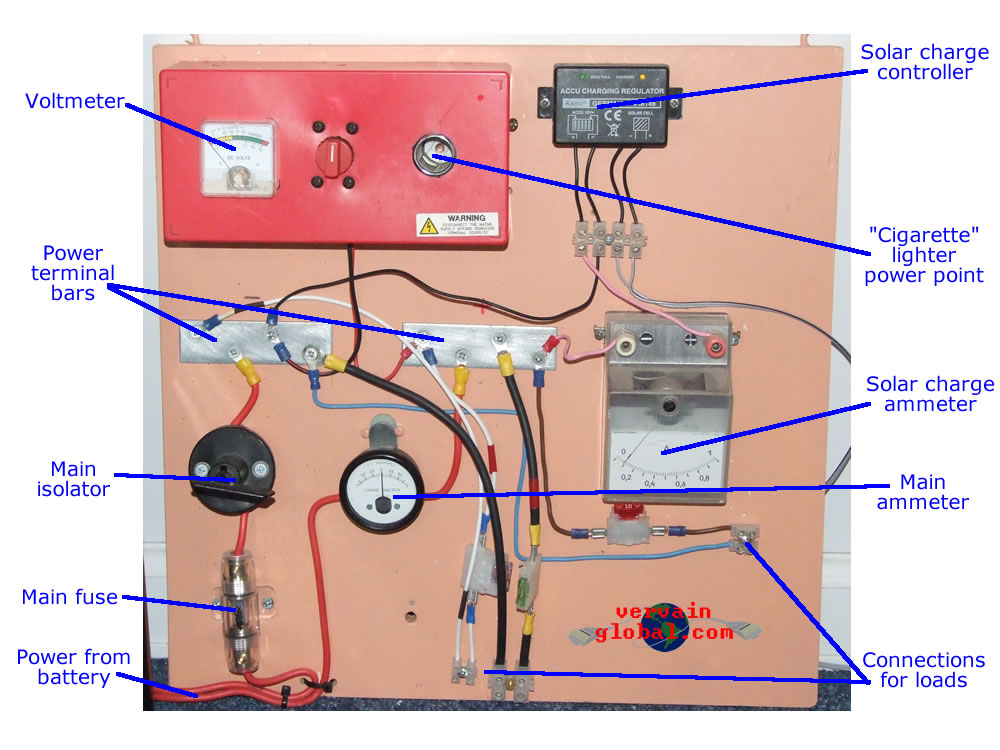Stand alone battery power system rundown
This page shows off a basic emergency or stand alone power system, charged by solar power. An easily available car battery is used for energy storage, and an inverter steps the voltage and current up to something suitable for operating mains appliances.
Components explained
The board shown below contains everything necessary to control and automatically charge your battery system. Each and every component has its importance, and although not all of them are completely necessary, they will make things easier. Everything on the board is available cheaply, and you may even be able to beg, borrow or steal some of it. This system will give you an emergency backup when the power fails, or just a source of alternative energy.

- Battery leads. These wires must be big enough to carry all of the load you will be placing on the battery. They should not get hot at any time during operation. Many wire sizing guides are available on the internet.
- Main fuse and Isolator. These two components are the most important safety feature, and will protect the system if something goes horribly wrong. The switch allows you to quickly shut everything down if you need to.
- Power terminal bars. These are where you will run all your connections to. They should be covered when you aren't accessing them, to prevent metal from touching them and causing a short. On systems above 24 volts, care should be taken never to touch these bare terminals, as you could receive a shock.
- Various meters. Although not necessary, having a volt meter and one or two ammeters will make it a lot easier to figure out what's going on. The solar charge ammeter is especially useful to know how much free energy is flowing into your batteries. A volt meter is advisable to get a rough idea of how charged your batteries are.
- Solar charge controller. This is important if you are using more than a few watts worth of solar panels. It will keep your battery correctly topped up, while stopping it from getting over-charged to the point of death. These range from about £10 to hundreds, but a basic cheap one is ideal for small systems that get little use.
- The connections that you make from your terminal bars will allow you to safely attach devices to your battery system. The thick black wires are for the inverter, as this draws a lot of current when loaded heavily. Other things you might want to attach are low voltage lights, a car stereo, CB radio stuff, and loads more. Always fuse every "tail", and perhaps add a switch if you feel the need.
- The "cigarette" lighter socket is used in almost every car, truck and van on the road. This is ideal for plugging in mobile phone chargers, lights, fans and all sorts of equipment available for the automotive market. Buying a mobile charging adaptor is often a lot cheaper than shelling out for an expensive inverter, so you might consider adding one to your system.
- A sturdy mount. All of this stuff should be mounted on a sturdy piece of board or MDF. This keeps it all secure and prevents the possibility of live terminals coming into contact with each other. It also makes the whole thing more portable.
That's pretty much all there is on a basic stand alone system. Once installed, the solar panels and charge controller will keep your battery topped up ready for that power cut, or just to help reduce you electricity bill a little. Could this system run your whole house? Of course not. Unless you have nothing more than a couple of lights of mobile phones. If you enjoy building this setup, you'll almost certainly add to it over time though. An extra solar panel now and then, another battery. Soon, you'll have a significant amount of electricity to play with!
More info on the larger components of this setup --- Learn basic electrical skills
